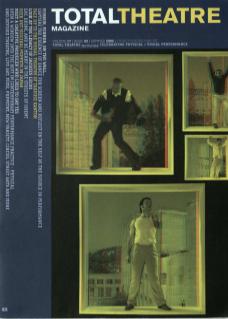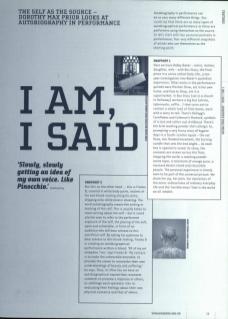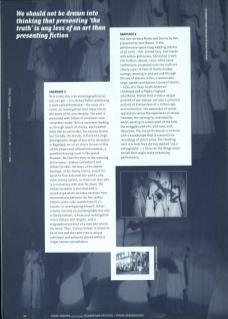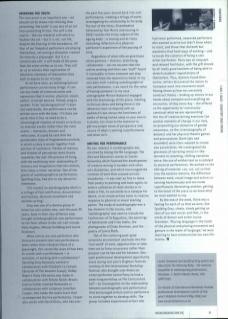Autobiography in performance can be so very many different things. You could say that there are as many types of autobiographical performance as there are performers using themselves as the source. So let’s start with four personal portraits in performance, four very different snapshots of artists who use themselves as the starting point:
Snapshot 1
Here we have Bobby Baker – artist, mother, daughter, wife – with Box Story, the final piece in a series called Daily Life, a ten-year investigation into Baker’s quotidian experience. Other works in the performance quintet were Kitchen Show, set in her own home, and How to Shop, set in a supermarket. In Box Story (set in a church in Holloway) we have a big box (shrine, tabernacle, coffin...) that turns out to contain a whole load of little boxes, each with a story to tell. There’s Kellogg’s Cornflakes and Coleman’s Mustard, symbols of a lost and rather sad childhood. There’s the Ariel washing powder she’s allergic to, prompting a very funny story of bygone days in a South-London squat – the cat fleas, the flooded basement, the burning candle that sets the bed alight... As each box is opened to reveal its story, the contents are strewn across the floor, mapping the world: a washing powder ozone layer, a rainstorm of orange juice, a mustard desert island and chocolate people. The personal experience is clearly seen to be part of the universal picture. We share her joy, her pain, her awareness of the extraordinariness of ordinary everyday life and the ‘terrible mess’ that is the world we all inhabit.
Snapshot 2
But this on the other hand... this is Franko B, covered in white body paint, rivulets of his own blood running along his arms, dripping onto white plastic sheeting. The word autobiography means the writing or marking of the self. This is usually taken to mean writing about the self – but it could also be seen to refer to the performed exposure of the self, the placing of the self, open and vulnerable, in front of an audience who will bear witness to this sacrificial self. By asking his audience to bear witness to this blood-letting, Franko B is creating an autobiographical performance written in blood. ‘All of my art embodies “me”,’ says Franko B. ‘My concern is to make the unbearable bearable, to provoke the viewer to reconsider their own understandings of beauty and suffering,’ he says. Thus, in I Miss You we have an autobiographical expose that resonates outwards to provoke a response in others, to challenge each spectator into reevaluating their feelings about their own physical existence and that of others.
Snapshot 3
Now surely this is as autobiographical as you can get – it is Joshua Sofaer presenting a work called Namesake – the story of a name, an investigation that takes him to the heart of his own identity. The work is presented with Sofaer in a lecturer-cum-storyteller mode. He is a raconteur leading us through layers of stories, each peeled back like an onion skin, his manner formal but friendly. He stands, in front of a large photographic image of two of his ancestors in Baghdad; we sit on chairs in rows in this rather proper and refined environment, a panelled drawing room in The Jewish Museum. We hear the story of the meaning of his name – Joshua (salvation) and Sofaer (scribe). We learn of his Jewish heritage, of his family history and of his quest to find and meet the world’s only other Joshua Sofaer, an American man who is a missionary with Jews for Jesus. The verbal narrative is enriched with a soundscape which includes excerpts from conversations between the two Joshua Sofaers and in situ sounds from JS l’s travels. In investigating himself, Sofaer creates not only an autobiography but also a family memoir, a historical investigation into a culture and religion, and a biographical portrait of a man who shares his name. Thus, ‘Joshua Sofaer’ is shown to be at one and the same time a unique individual and someone placed within a larger human constellation.
Snapshot 4
And now we have Myths and Stories by Her, presented by Jane Bacon. In the performance space hang wedding dresses of all sorts – full-skirted fairy-tale frocks with cotton petticoats, Edwardian cream silk mutton-sleeves, snow-white nylon confections; projected onto the cloth are cheery super-8 films of family holiday outings; weaving in and out and through the sea of dresses is Her, a woman who sings, speaks and dances a book of stories – tales of a Deep South American childhood and a Middle-England adulthood. Stories that create a unique portrait of one woman, yet also a universal portrait of Everywoman of a certain age and inclination: the awareness of sexual oppression versus the experience of sexual freedom; the striving for individuality whilst wanting to remain part of the fold; the struggles with life, with love, with liberation. The live performance is intercut with a soundscape that is created from recordings of Jane’s voice. The resulting work is a form that she has dubbed ‘autoethnography’ – a focus on the things about herself that might make interesting performance.
Inventing the Truth
This last point is an important one – we should not be drawn into thinking that presenting ‘the truth’ is any less of an art than presenting fiction. The self is the source – the raw material with which to fashion the art – but it is art, not life, despite the blurring of the boundaries. All four of our Snapshot performers are playing themselves, not acting a character created for them by a playwright. But it is a constructed self, a self made of the parts that the artist wishes us to see. They call on us to witness their exploration of whichever elements of themselves they wish to expose to our scrutiny.
As we have seen, an autobiographical performance can be many things. It can use any mode of communication and expression that it wishes: physical, visual, verbal. It can be danced, filmed, sung or spoken. To be ‘autobiographical’ it does not need words, the performance can be written on or with the body. If it does use words then it has no need to be a chronological citation of events or to focus on external events rather than the inner events – memories, dreams and reflections. It could be said that the postmodern style of fragmented narrative, in which a story is woven together from patches of revelation, flashes of memory and threads of perception, more closely resembles the real-life process of living, with the continuing inter-relationship of memory and imagination that this entails, than many a linear narrative. One of the giants of autobiographical performance, Spalding Gray, had this to say about his intentions:
‘[To create] an autobiography which is a collage of fact and fiction, documentary and fantasy, abstract movement and realistic acting.’
Gray was one of a diverse group of American solo artists who, over the past 30 years, have in their very different ways brought autobiographical solo performance to the fore: others in the roll-call include Holly Hughes, Whoopi Goldberg and Laurie Anderson.
“Slowly, slowly getting an idea of my own voice. Like Pinocchio.” Spalding Gray
When artists are solo performers who choose to present their own performance texts rather than interpret those of a playwright, this raises the issue of how best to create such a performance – in isolation, or working with a collaborator? Spalding Gray famously worked in collaboration with Elizabeth Le Compte (director of The Wooster Group); Bobby Baker's Daily Life series was made in collaboration with Polona Baloh-Brown; Joshua Sofaer created Namesake in collaboration with composer Jonathan Cooper, who made the audio track that accompanied the live performance. Cooper also works with David Glass, who has over the past few years moved back into solo performance, creating a trilogy of works investigating his relationship to his body. The last of the three, Disembodied (directed by Tom Morris and touring in 2005) tackles the tricky subject of the ageing body – a moving and at times disturbing reflection on a physical performer’s experience of the passing of time.
Regardless of what title we give these silent partners – director, dramaturg, collaborator – we can assume that the artists working with their own ‘stuff’ found it invaluable to have someone one step removed from the material on hand. In my own past work creating autobiographical solo performance, I can vouch for the value of having someone (in my case scenographer Miriam Nabarro) engaged with the dramaturgy of the piece, meeting to discuss ideas and being there in the rehearsal room to respond with an audience’s eye versus the loneliness of weeks of being locked away on your own in a studio, too close to the material to get any proper sense of perspective and unsure of what is working in performance and what isn’t.
Writing for Performance
My own interest in autobiography was enriched by taking the MA Language, The Arts and Education course at Sussex University which fostered the development of creative writing in tandem with other arts disciplines, and which encouraged the creation of work that crossed artistic boundaries – it was seen as fine to move from poetry to painting and back again, to write a collection of short stories or to make a film, to use words as a catalyst for dance, or to create written texts in creative response to physical or visual starting points. The study of autobiography was a key element to the course, and ‘autobiography’ was seen to include the Confessions of St Augustine, the paintings of Rembrandt and Frida Kahlo, the photography of Cindy Sherman, and the poetry of Sylvia Plath.
Out of the nurturing post-grad university environment and back into the ‘real world’ of work, opportunities to take time out to focus on process rather than product can be few and far between. One such professional development opportunity arose during last year’s Brighton Festival, courtesy of the International Workshop Festival, who brought over American writer/performer Janice Parry to lead a week-long workshop on The Constructed Self – an investigation on the relationship between autobiography and performance that encouraged writers and/or performers to come together to develop skills. The group included experienced writers who had never performed, seasoned performers who wanted to write but didn’t know where to start, and those that did both but wanted to find fresh ways of working – and to break the isolation of being a solo writer/performer. Parry was an eloquent and relaxed facilitator, with the gift shared by all really good teachers of being able to stretch students’ expectations of themselves. Thus, dancers found their voices, writers discovered the means to transpose word into movement motif. Having shown us how we constantly construct theory – making up stories in our heads about everyone and everything we encounter, all day every day – she offered us the opportunity to ‘consciously construct what we are representing’. Her mix of creative writing exercises (on pivotal moments of change in our lives, on pinpointing our memories of gender awareness, on the cinematography of dreams) and her physical theatre games and provocations (both solo and ensemble) were interweaved to create new possibilities. We investigated the processes of narrating versus in-the-moment re-enacting; shifting narrative voice; the use of written text as a catalyst to physical performance. We worked on the editing of material: cut, cut, cut so that only the essence remains; the difference between word, visual image and action coexisting harmoniously and one mode superfluously illustrating another; getting to the heart of the piece so we knew what we most wanted to say.
By the end of the week, there was a feeling for each of us that we were, like Spalding Gray, slowly, slowly getting an idea of our own voices and that, in the words of dancer and writer Louise Steinman: ‘Placing language in the realm of the physical and placing movement and gesture in the realm of language,’ we were learning to best communicate our own life-stories.
Louise Steinman and Spalding Gray quotes are taken from The Knowing Body – the artist as storyteller in contemporary performance. Steinman, 5. North Atlantic Books, USA, 1986/1995. For details of International Workshop Festival professional development courses at this year’s Brighton Festival (May 2005) see: www.workshopfestival.co.uk



